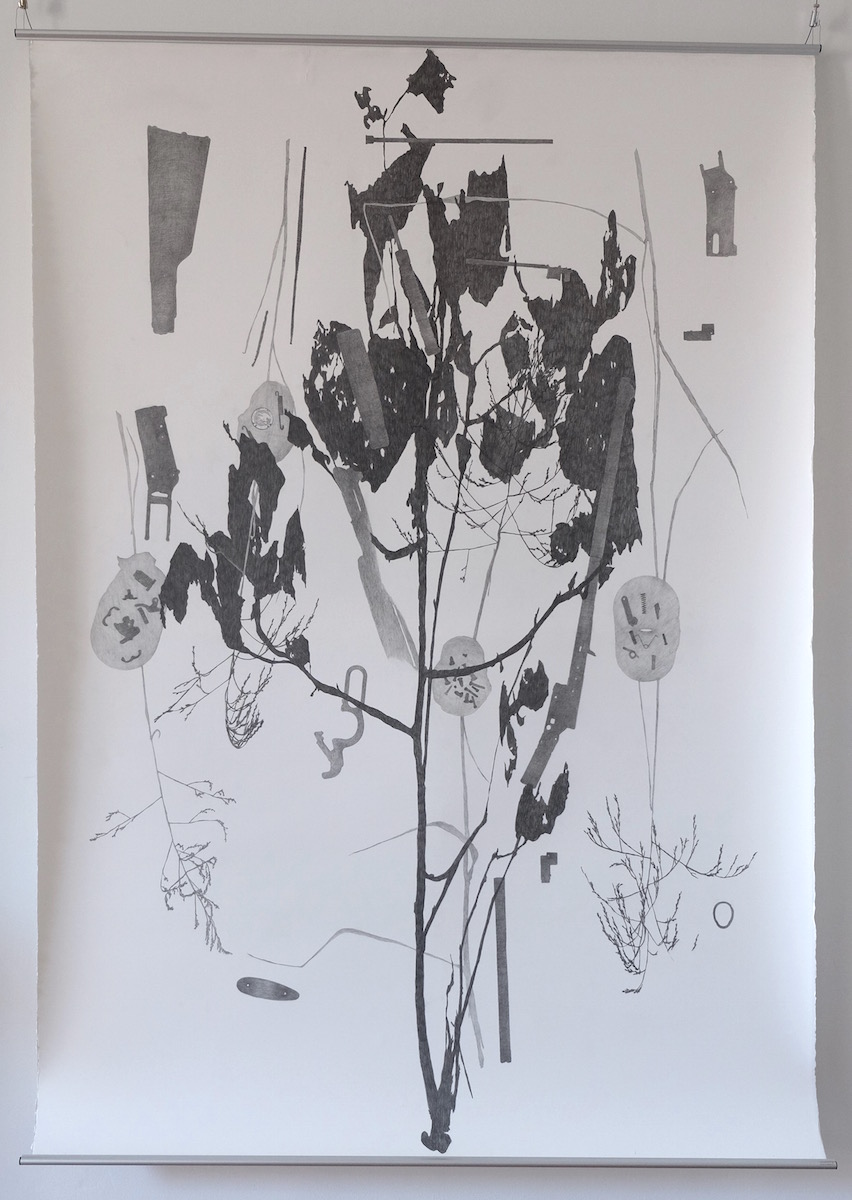About Renee
Baltimore County
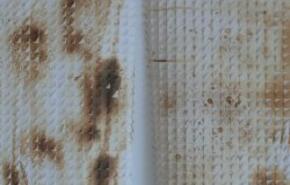
Renee van der Stelt's visual practice and research focuses on contemporary drawing, with recent focus around complexities of human relationships toward the natural environment, mapping and revealing overlooked spaces, including the politic of the body in contested space. She has received grants and residency awards in support of her work including the Pollock-Krasner Foundation, Maryland State Arts Council, BOPA, TKF Foundation, MacDowell Colony, Roswell Artist in Residence, and Kaus Australis… more
Jump to a project:
2017-2018 Sampling of Work
Detail image: Two drawings from a previous series of drawings in which only two actions were repeated: score / fold.
My work represents a range of investigations concerning drawing as a question, as an ongoing practice of inquiry into ways the world might be seen. The goal is not to always make an object, or to find an answer - but to sustain the question, using drawing as the vehicle for understanding experience. With an MFA in Drawing from the University of Iowa (early 1990's) I continue to practice & explore what drawing means as a visual form of philosophy. The act of drawing is a direct (non-linguistic) way to express complexity of thought through sight and movement with shifting tools at hand. The continuous thread that lies in my process is the impulse to learn through quietly looking and drawing many things that are difficult to understand. To eek out deeper dialogue in relation with things not necessarily socially engaged or driven.
In particular, while my studio practice often still uses paper in traditional ways, the investigations have been moving outside with an awareness of the rich landscape around, knowing that context is often half the meaning. What are the politics of space, and how does one listen to that? What is it's history, and who gets to decide how a place will be used and seen? In exploring space through drawing as an open approach, the politic of body and territory are becoming more clear: I seek to reveal hidden events on the land - things that are overlooked - and with a resonance of past next to desperation of present shifting climate change. Putting an ear to the ground, drawing helps me listen.
My work represents a range of investigations concerning drawing as a question, as an ongoing practice of inquiry into ways the world might be seen. The goal is not to always make an object, or to find an answer - but to sustain the question, using drawing as the vehicle for understanding experience. With an MFA in Drawing from the University of Iowa (early 1990's) I continue to practice & explore what drawing means as a visual form of philosophy. The act of drawing is a direct (non-linguistic) way to express complexity of thought through sight and movement with shifting tools at hand. The continuous thread that lies in my process is the impulse to learn through quietly looking and drawing many things that are difficult to understand. To eek out deeper dialogue in relation with things not necessarily socially engaged or driven.
In particular, while my studio practice often still uses paper in traditional ways, the investigations have been moving outside with an awareness of the rich landscape around, knowing that context is often half the meaning. What are the politics of space, and how does one listen to that? What is it's history, and who gets to decide how a place will be used and seen? In exploring space through drawing as an open approach, the politic of body and territory are becoming more clear: I seek to reveal hidden events on the land - things that are overlooked - and with a resonance of past next to desperation of present shifting climate change. Putting an ear to the ground, drawing helps me listen.
-
SolitaryThis work places the dimensions of a solitary confinement cell (8x10') from many US prisons onto the outdoor property of a privately owned property in rural Maryland. The Tulip poplars are self seeded, but left to stay when the meadow was cut. They are still being pruned and tied to form 'walls.' The pruner was found in the property garage. String from the pruner hangs outside the edges of the trees. The contrast of confined prison space and outdoor 'open space' causes consideration of how bodies and territories are situated in the US. Who is allowed on rural land, who is not? And Why? It is critical that this work is experienced in person and not from a distance through such images.
-
UNHCR TentA UNHCR tent for a family of 5 was measured out when this field was a meadow with a lot of self-seeded Tulip Poplar saplings. The saplings that fell into the area of the tent were left to grow and stand as the walls of the tent. The saplings that were all around the standing and pruned trees were bundled into five cut bunches of barren/dead saplings and placed inside the overall outdoor environmental work. The work in 2018 looks different: grasses are longer around the trees, and grass inside the dimensions of the 'tent' are cut with a weed-wacker.
-
 BURY TRUST BORDERThe box is connected by string to another black box reading SECRETS OUR US THE on sides and inside an infinity symbol on base of box. DEEP FEAR also written on inside of Box. Both boxes have been installed on two sites outside. The work engages a discussion of land/territory/borders, and how fear, ownership and sense of place/space are always connected, revealing the politics of the human body.
BURY TRUST BORDERThe box is connected by string to another black box reading SECRETS OUR US THE on sides and inside an infinity symbol on base of box. DEEP FEAR also written on inside of Box. Both boxes have been installed on two sites outside. The work engages a discussion of land/territory/borders, and how fear, ownership and sense of place/space are always connected, revealing the politics of the human body. -
Snake DrawingOne of several land drawings made in the last few years on a hillside near home. The drawings are ephemeral and change as the year passes or growth patterns change. How the land drawings are photographed - including vantage point - is also under investigation. Part of this project includes waiting for the land markings to be photographed by satellites then 'found' online months later. What does it mean for how hard is seen today when images of these land drawings are collected for a distant view much later and from vast distances? Who is the audience, and how do human audiences/contexts shift? The ongoing project was begun when it was noticed that images of land are often re-photographed and posted on the internet annually. I have been learning more about the Native American burial grounds again, after finding an arrowhead in the soil at home. I am considering ways to have an art relationship with the earth that is not destructive or static: to allow the art work to breathe and blend back into the land so that marks made and all the effort that lies behind the work of my body is gentler, listening.
-
Point, Line & Stone III, IVCompose collected stones: place, move, measure volumes between, shift, mark the border as line between points. Repeat. Set stone next to image of stone: adjacent shifting reality.
-
 Rural LandscapeRecorded movements of seeds, leaves, ants, debris fallen on the paper and marked over the course of a year. Text then added later with lines measured and held on top of text. The drawing is a portrait of white land ownership and what lies beneath the soil and history of taking land for personal gain.
Rural LandscapeRecorded movements of seeds, leaves, ants, debris fallen on the paper and marked over the course of a year. Text then added later with lines measured and held on top of text. The drawing is a portrait of white land ownership and what lies beneath the soil and history of taking land for personal gain. -
 Tremor in ShadowShadows of Tulip Poplar sapling, Switchgrass & dispersed parts of a gun taken apart (NRA 1976 commemorative gun found in rural attic).
Tremor in ShadowShadows of Tulip Poplar sapling, Switchgrass & dispersed parts of a gun taken apart (NRA 1976 commemorative gun found in rural attic). -
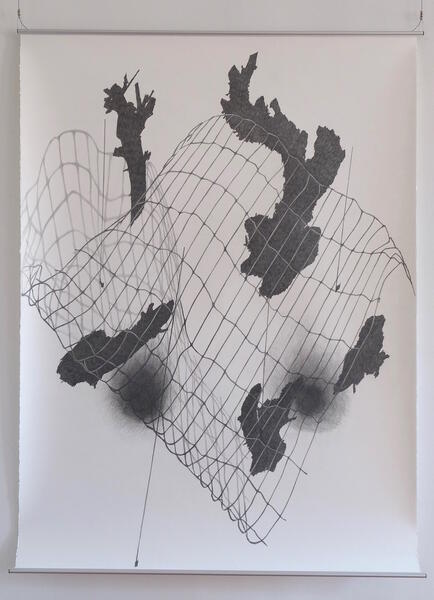 Shadows TerritoryShadows of apple wood struck by lightning, land-marking flags, and torn metal fence.
Shadows TerritoryShadows of apple wood struck by lightning, land-marking flags, and torn metal fence. -
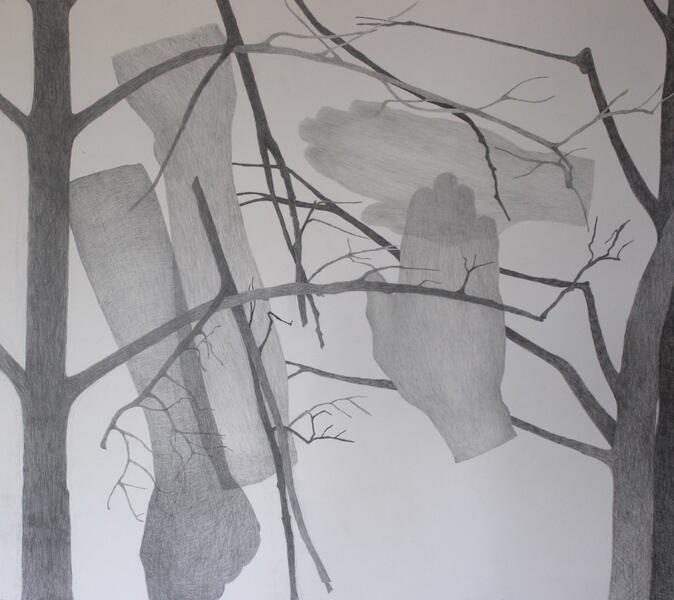 Caught: Widow Maker
Caught: Widow Maker -
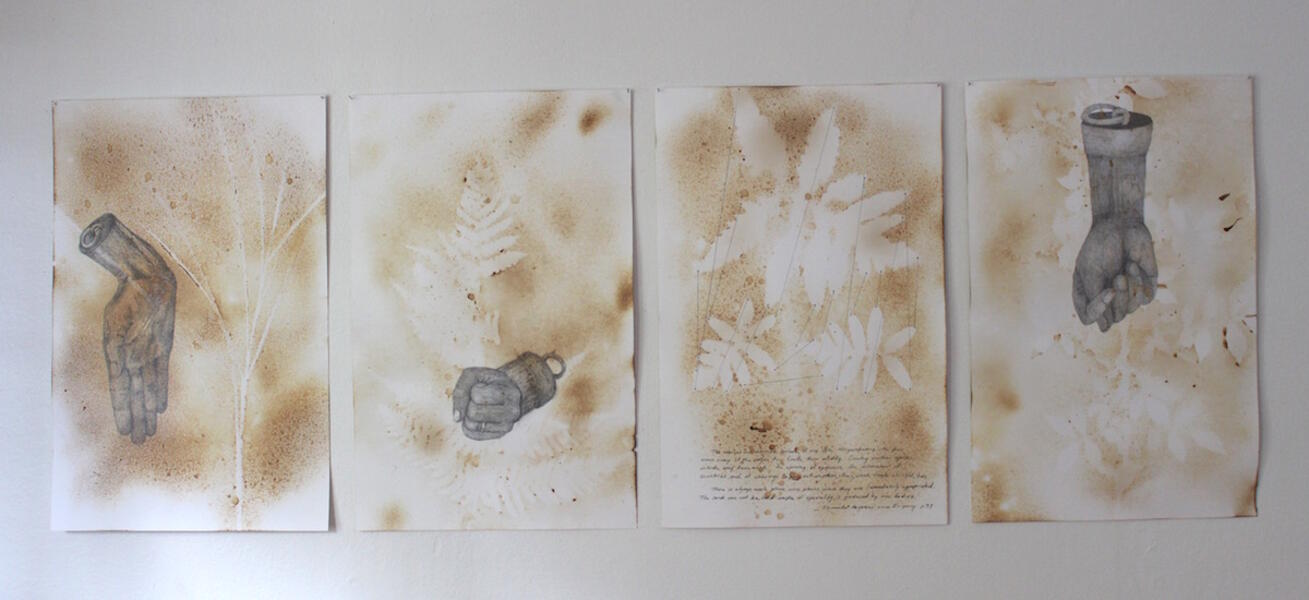 ClenchThree hands with quote from "Elemental Passions". Lemon juice reveals organic forms laid on paper before graphite drawings were made.
ClenchThree hands with quote from "Elemental Passions". Lemon juice reveals organic forms laid on paper before graphite drawings were made.


